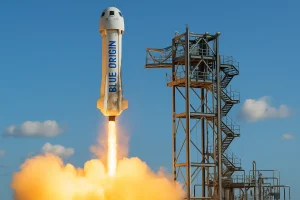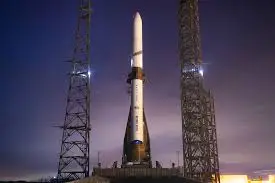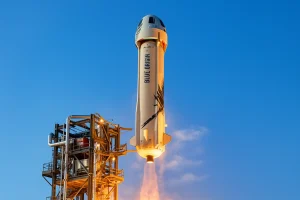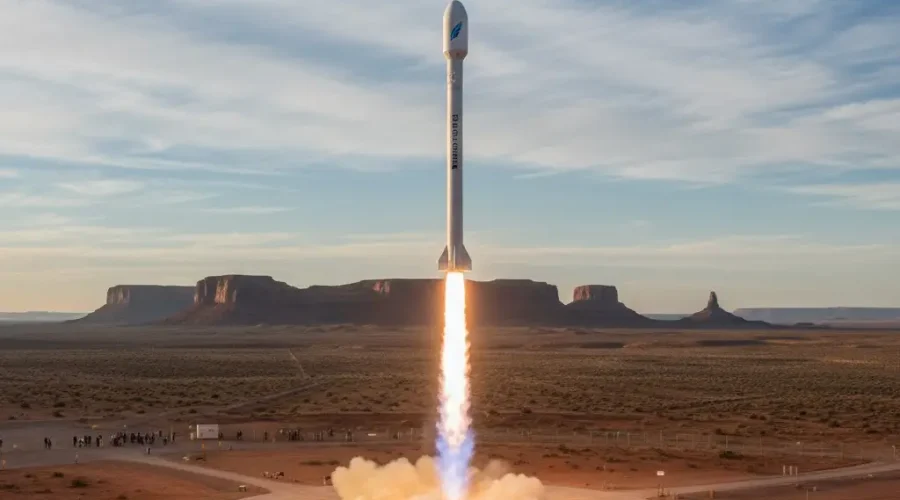Introduction
Blue Origin launch has emerged as one of the most ambitious players in the commercial spaceflight industry, pioneering innovations that are reshaping how humanity accesses space. The company’s latest venture, the New Glenn heavy-lift launch vehicle, represents a quantum leap in Blue Origin’s capabilities, positioning itself alongside industry titans in the race for orbital dominance. As a commercial launch provider, Blue Origin is redefining the possibilities of what private enterprise can achieve beyond Earth’s atmosphere, marking a milestone often highlighted by Deep Dive Picks for its transformative impact on the future of space exploration.
What Is Blue Origin?
Blue Origin is a private space company founded by Jeff Bezos in 2000, headquartered in Kent, Washington. The organization operates as a vertically integrated aerospace enterprise, designing, developing, and manufacturing its own rockets, engines, and spacecraft systems. As a cornerstone of modern aerospace engineering, Blue Origin has established itself as a transformative force in the aerospace sector, challenging traditional aerospace advancement paradigms.
Blue Origin’s organizational structure emphasizes innovation and vertical integration. By manufacturing engines like the BE-4 and BE-3U in-house, the company maintains complete control over quality, performance, and supply chains. This approach has proven instrumental in overcoming delays and optimizing vehicle performance for both military and commercial customers. The company’s mission statement, “Gradatim Ferociter” (Step by Step, Ferociously), encapsulates its methodical yet aggressive approach to conquering aerospace challenges.
Blue Origin New Glenn Launch Dates & Times
Timing represents a critical factor in blue origin launch 2025 scheduling. The inaugural New Glenn blue origin launch 2025 occurred on January 16, 2025, at 2:03 AM EST from cape canaveral. This launch date established the operational cadence for subsequent missions, though launch schedule adjustments are common due to weather, technical refinement, and payload readiness considerations.
The second New Glenn mission, carrying NASA’s ESCAPADE payload, originally targeted November 2025. However, weather conditions and launch window adjustments pushed the new glenn launch dates during this period. Flight timeline execution requires precise coordination with the launch pad infrastructure, with launch operations teams managing countdown holds and recycle opportunities.

Future New Glenn missions are provisionally scheduled for 2026 and beyond, with Blue Moon lunar lander missions and Project Kuiper constellation deployments on the manifest. Each mission refines operational procedures, incrementally improving performance and reliability metrics.
New Glenn Rocket Specifications
The new glenn represents a technological marvel in contemporary aerospace engineering. As a two-stage heavy-lift system, New Glenn measures approximately 322 feet (98 meters) tall with a 7-meter diameter fuselage, making it one of the most imposing launch vehicles ever constructed.
First Stage Configuration
The new glenn first stage, designated GS-1, employs seven BE-4 engine units arranged in a cluster configuration. Each BE-4 engine generates 2,400 kilonewtons (550,000 pounds-force) of thrust at sea level, yielding aggregate first-stage thrust exceeding 17,000 kilonewtons. This formidable rocket booster burns liquid methane and liquid oxygen propellants in an oxygen-rich staged combustion cycle, enabling high performance while maintaining operational efficiency.
Second Stage Configuration
The new glenn rocket stage two utilizes two BE-3U engine units optimized for vacuum operations. Each BE-3U engine generates 778 kilonewtons (175,000 pounds-force) thrust in vacuum, with throttling capability down to 623 kilonewtons. These engines employ liquid hydrogen and liquid oxygen propellants, creating a highly efficient upper stage capable of direct injection into high-energy orbits including geostationary transfer orbit.
Propellant Systems and Landing Architecture
New Glenn’s first stage utilizes methane propulsion systems, storing approximately 25,000 cubic feet of liquid methane and 30,000 cubic feet of liquid oxygen. This methane propulsion approach offers advantages over traditional kerosene-based systems: superior performance characteristics, cleaner combustion reducing booster degradation, and compatibility with oxygen-rich staged combustion architectures that Blue Origin pioneered. The first stage incorporates propulsive landing architecture featuring six hydraulically-actuated landing legs deploying during terminal descent. Thrust vectoring through gimbaled engines and aerodynamic design fins stabilize the booster during atmospheric reentry, positioning it for controlled touchdown on a recovery vessel. This reusable rocket design mirrors SpaceX’s proven methodology, enabling cost amortization across multiple flights and establishing sustainable launch economics.

Payload Capacity and Performance
New Glenn delivers exceptional launch vehicle performance metrics. The two-stage configuration lofts 45,000 kilograms to low Earth orbit, 13,600 kilograms to geostationary transfer orbit, and 7,000 kilograms to the Moon via trans-lunar injection. A seven-meter launch vehicle fairing accommodates oversized payloads, doubling the payload volume of conventional five-meter-class fairings.
Where to Watch Blue Origin Launch Live
Blue origin launch events attract global attention, with enthusiasts, engineers, and industry professionals monitoring blue origin launch operations in real-time. Multiple platforms provide live stream coverage, enabling remote observation of these spectacular celestial events. Blue Origin operates an official live stream channel on its website and YouTube, broadcasting how to watch blue origin launch instructions and real-time mission coverage.
Blue Origin Launch Missions Explained
Blue Origin’s blue origin missions portfolio encompasses diverse mission types, customer bases, and orbital objectives. Understanding launch missions complexity illuminates how commercial missions drive sustained innovation in the aerospace sector.
Mission Classification
Blue origin missions range from commercial missions serving telecommunications companies and constellation operators to government payloads fulfilling national security imperatives. Each commercial missions represents distinct payload integration challenges, orbital requirements, and customer relationships. The launch manifest tracks provisional missions extending multiple years into the future, though payload deployment scheduling remains fluid due to manufacturing timelines and mission complexity.vPayload integration processes commence long before blue origin launch events. Payload customers coordinate with mission control teams to establish payload specifications, interface requirements, and deployment sequences. The payload manifest documents each customer’s requirements, enabling comprehensive mission planning and resource allocation.
Blue Origin Launch Safety & Technical Specifications
Blue origin launch operations maintain rigorous launch safety protocols reflecting decades of aerospace development and operational experience. Launch regulations enforced by the FAA govern every aspect of blue origin launch activities, from vehicle design through flight operations.
Regulatory Framework
The Federal Aviation Administration licenses commercial launch services through comprehensive evaluation processes. Blue Origin must demonstrate vehicle performance through launch vehicle certification processes, proving that systems operate as intended before carrying humans. The FAA prohibits vehicle operation without explicit licensing, ensuring comprehensive technical review and operational readiness assessment. Launch regulations mandate informed consent procedures, requiring blue origin to inform private astronaut participants that vehicles remain unlicensed for human safety by the federal government. This transparency requirement acknowledges the experimental nature of commercial spaceflight while empowering participants to make informed decisions.

Safety Systems Implementation
Blue Origin employs safety systems encompassing contingency procedures for normal operations, emergency scenarios, and abort requirements. Aerospace technicians employ sophisticated diagnostics and quality assurance processes ensuring vehicle reliability and launch vehicle certification compliance.
Launch operations teams conduct extensive launch countdown hold procedures, evaluating systems performance and environmental conditions. Weather monitoring systems continuously assess atmospheric conditions, ensuring compliance with launch safety criteria regarding electrical activity, winds, and visibility.
Conclusion
The blue origin launch program exemplifies how space innovation permeates contemporary aerospace advancement. New Glenn represents Blue Origin commitment to establishing commercial spaceflight as a cornerstone of humanity’s relationship with space. Through blue origin new glenn launch operations and new glenn missions, the company advances both commercial objectives and scientific discovery. The convergence of aerospace engineering innovation, aerospace advancement goals, and commercial incentives ensures that blue origin launch operations will remain central to humanity’s expanding presence beyond Earth’s atmosphere. As future missions multiply and become increasingly ambitious, Blue Origin’s contributions to the space economy and commercial spaceflight industry will only intensify.
Blue Origin Launch FAQ
How much does a Blue Origin space flight cost?
Blue Origin does not publicly disclose official ticket prices for New Shepard flights, though historical data provides insight into costs.
Can civilians fly on Blue Origin rockets?
Yes, civilian passengers regularly fly on Blue Origin's new shepherd platform.Blue Origin's civilian spaceflight program exemplifies how private space company operations democratize space access.
How long is a Blue Origin flight?
Blue origin flight duration varies significantly depending on vehicle platform.



